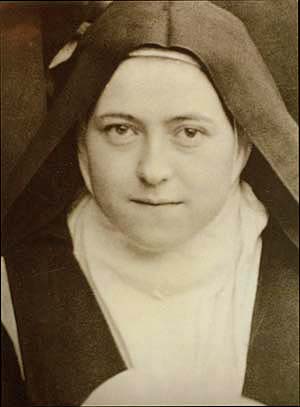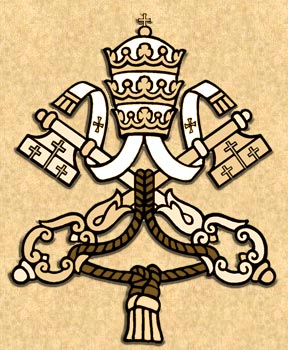Biographical Section
In the summer of 1215 St. Francis with a small group of friars were in Rome seeking approbation for his Rule. One night during his stay while Francis was praying, he saw Our Lord prepared to unleash most terrible chastisements upon the world. His Most Holy Mother was making an effort to placate Him, asking His mercy and forgiveness. For this purpose, she presented two men who would labor for the conversion of the world and return a countless number of lost sheep to the fold. Francis recognized himself as one of these apostles. He did not recognize the other one, however.
The following day, he was in one of the churches of Rome when suddenly an unknown person came up to him, embraced him, and said: “You are my companion, we will work together, supporting one another toward the same end, and no one will prevail against us.” Francis recognized him as the other man in the vision. It was St. Dominic, who had also received a similar vision. When he saw Francis in that church, he immediately went to greet him, inspired by the Holy Ghost.
Sometime after this encounter, Francis and Dominic assisted at a service at St. John the Lateran Basilica where a famous preacher was giving a sermon. It was Fr. Angelo who later would die a martyr in Sicily. As he preached, Fr. Angelo saw Francis and Dominic in the audience. Moved by a grace, he stopped, looked at them, and announced with prophetic words that the two would be strong columns of the Church.
At the end of the ceremony, St. Angelo waited for them, embraced them, and told them the favors God had reserved for them. The two founders, in turn enlightened by a supernatural grace, revealed the principal events of the life of St. Angelo. As the trio left the church, they came upon a leper begging there. The three gave a simultaneous blessing to the poor man, which restored him to health.

(St Francis receiving the Stigmata by Giotto)
Comments of Prof. Plinio:
This narration is so beautiful that I feel embarrassed to comment on it. But since I have the obligation to say some words to you regarding it, I will do so.
You see the splendor of the scene. St. Francis and St. Dominic both received visions that allowed them to recognize one another. So when St. Dominic saw St. Francis in one of the churches of Rome, he went to him and embraced him. They both expressed their enthusiasm for the mission each had received and for the fact that they would support one another. This was the embrace of two souls, each one with every reason to hold the other in the highest esteem: on one hand, because their missions were very similar; on the other hand, because they were very different.
According to Catholic criteria, a great similarity leads to friendship, but so also does a great dissimilarity when it is not the dissimilarity of opposition, but rather one that is complementary. One had something that the other was lacking. Together they constituted a harmonic ensemble. For this reason, they admired one another.
Both saints had a profound Marian devotion. St. Francis was a great palatine of the Immaculate Conception centuries before it was defined as dogma. The Franciscans would spread that truth throughout the world. St. Dominic was the great apostle of the Rosary. Through the devotion of the Rosary the Dominicans would effect immediate and spectacular conversions. The Dominican is the Order of the Rosary par excellence. So, from the Marian perspective, there is a great similarity in the Orders.
However, even with this similarity of mission, there are also differences. The two Marian devotions represent in the minds of the faithful two different floods of light. Still, they are convergent lights, because it is not unusual for the person who believes in the Immaculate Conception to pray the Rosary, and vice-versa.
This balance between similarity and dissimilarity can also be noted in another point. The Dominican Order was called to convert persons by speaking to their will through their intelligence. It is clear that part of the Dominican mission is an intellectual work – the study and teaching of philosophy, theology, and apologetics. On the contrary, the dominant note of the Franciscan Order is to move the will through a manifestation of zeal. The great conversions of the Franciscans came about through the consideration of the Wounds of Our Lord, His Passion, His poverty and spirit of sacrifice. Once again, they are harmonic differences that merge in the spirit of the faithful. A Catholic instructed in the arguments of apologetics by the Dominicans should also be touched by the fervor of the Franciscans.
That embrace in a church of Rome, therefore, was not just the embrace of two saints, but something more. It was the missions of the two Orders that embraced in that moment. The two Founders were like the two hands of God uniting their efforts to work on this earth, to bring holiness and happiness to men and glory to the Catholic Church.
This was further completed by the presence of a third saint. The saint who preached from the pulpit was so famous that both Francis and Dominic came to hear him. In the middle of his sermon, St. Angelo sees what it is not given to human eyes to see: he sees the future of St. Francis and St. Dominic and how they would become strong columns of the Church and Catholic Civilization, which was threatening to crack and break.
Finally, the three men met and embraced at the end of the office. What did the Carmelite preacher St. Angelo bring to that embrace? He brought what was missing: martyrdom. He brought his acceptance of the holocaust and immolation of his very life in honor of Our Lord Jesus Christ and as a witness to the truth of the Catholic Faith.
Simplifying the picture, then, we have wisdom, charity and martyrdom that merge in that encounter and work a miracle. A leper was at the door of the church begging. Leprosy was the worst and most incurable illness of the time. The three Saints made a joint blessing over the leper, and the man was cured. This symbolized a Christendom that was becoming leprous and which, by the action of those saints, was restored to health.
This is how we can understand the first part of the selection. The Revolution was installed in Christendom and Our Lord was ready to release His punishments. But Our Lady intervened, pointing to the mission of those two men, and she obtained the postponement of that chastisement, because the action of the Revolution would be deferred by the action of those two saints.
In the 15th century the Revolution entered again with new force. Why did this happen? Did God call another man to halt it? In this case, we would be facing the possibility that a new St. Francis was called and did not correspond to his vocation. Or perhaps the man corresponded and became a saint – St. Vincent Ferrer, for example – but the people did not correspond to his appeal. We do not know. What is certain is that from the 15th century on, the collapse of Christendom has been continuous.
We can see the preventive counter-revolutionary action of St. Francis of Assisi. By means of humility, purity and austerity, he put a brake on the pride and sensuality of his times.
We should ask St. Francis, through the grand union he has with Our Lady, to obtain for us a great spirit of humility and mortification so that we stop thinking about ourselves and think only on the Catholic cause, without the desire to appear, shine, or have fun. It should suffice for us only to know, love, serve and glorify Our Lady through our whole life. We should also ask him to help us fight with all our forces to destroy the Revolution, which he helped to counter-attack in his times.

(Tomb of St. Francis of Assisi)















